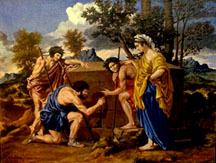|
Annotations


o A brief outline by James Burt of "Holy Blood, Holy Grail,"
a book very important to understanding some of the references in this
story: Berenger Sauniere (BS) renovated the church at Rennes le Chateau
(RlC) and somehow came into money at the same time. There is a lot of
debate as to what the treasure at RlC is, but there is the idea that
it is related to the head which the Templars worshipped. The order of
the Knights Templar were later suppressed due to their heresy and worshipping
of graven idols. The painter Nicholas Poussin (who painted King Mob's
postcard) enters the story as he made a hint in a letter about a great
treasure. He was later imprisoned, and held incommunicado. Louis XIV
then hunted down the original of the painting 'Les Bergers d'Arcadie'
and when he found it hung it in his private quarters. The tomb shown
in the picture, reading IN ARCADIA EGO, was found in the early 1970s
in...Rennes le Chateau. The story leads to the discovery of the 'Prieure
de Sion,' an ancient conspiracy who guard the bloodline of Christ, ready
to reveal it when the conditions are right [the model for the Grail
in Preacher- yes, all the UK comics writers rip off the same sources
:-) ] There is a lot of rubbish in the book, but it proved very popular,
and seems to answer a number of questions about certain historical mysteries.
However, the authors relied on too many ancient texts which later 'disappeared',
if they ever existed at all. The Annotations

o [page 1] The dalang (the puppeteer) is telling a story very
similar to the basic idea running through all the Invisibles issues:
there are two (apparently) opposing forces fighting to control or to
free the humanity. But the true meaning of the story is that the two
forces are maybe only one--two sides of the same coin. [PV]

o [page 2] The text shown in this page is from "Julian and Maddalo"
by Shelley, a suggestive picture of himself in comparison to Byron's
portrayal. [PV]

o [page 3] [panel 4] Poussin, Nicolas (Les Andelys, France 1594
- Rome, Italy 1665). [PV] From Benet's: "French painter. The great master
of the classical school, Poussin worked chiefly at the studio he established
in Rome. In his rational, clearly composed paintings of mythological,
historical and religious scenes, he imitated the measured gestures of
antique sculpture and the clean draftsmanship and effortless order of
Raphael. His work exerted an enormous influence on the course of art..."
[JB] The painting referred to here is at the Louvre. [PV]

o [page 6] [panel 3] Ganesh, the Hindu god "who breaks down obstacles."
We'll see another reference to King Mob's god in 2.3 [PV] Ganesh is
invoked in 2.2 as well. [CG] panel 5: The "shortpath" is a reference
to KM's ability to shift between universes (more on it in 2.06). [RL]

o [page 8] Boy says "something happened to one of our members."
She's referring to John-A-Dreams. See 1.01, page 6, panel 4 for first
reference to him; also see 1.09, pages 1-3, for his first appearance.
[JB]

o [page 9] [panel 5] Who's the pianist? [PV] I may be mistaken,
but I believe this whole sequence with Byron and Shelley visiting the
asylum is all accounted in the poem "Julian and Maddalo" including the
guy playing the piano. The poem is supposed to be based on actual conversations
and events. I'm not sure who this real person was. I'm not sure if this
is correct. [CH]

o [page 11] [panel 3] Boy's speech here becomes far more significant
in the light of 2.11 [RJ]

o [page 12-13] Uh... Where/when is this scene taking place? [JB]

o [page 16] [panel 2] Ragged Robin gives further proof of her
psychic ability, foreseeing the exact moment of KM's arrival. [PV] Well...
later on in "Entropy in the UK" [1.17-1.19], Robin has to call in Jim
Crow to find KM, as he is normally totally "psi-invisible." Therefore,
just to be picky, the issue 5 bit is either a) a boo-boo by Grant or
b) Robin trying to impress the others with her psychic mastery although
she just saw him in the window or something. [RD]

o [page 17] [panel 1] We'll learn more about Jim Crow in 1.10.
[PV]

o [page 19] Here's the actual postcard pictured in panel 2...
[BvS]
  
  
  
The Invisibles seem to have encountered Orlando before yet he does not
know that Fanny is a trannie. Or did they only know of Orlando from
Fanny telling them all what she saw when she was initiated (1.13-15)?
[L]

o [page 20] [panel 4] The windmill-time machine is a reference
to the Gideon Stargrave character (for more info see 1.17, page 21,
panel 4). [PV]

o [page 24] [panel 1] The executee is reciting Psalm 23, a common
one for those who are dying or dead. [CG]
|















































